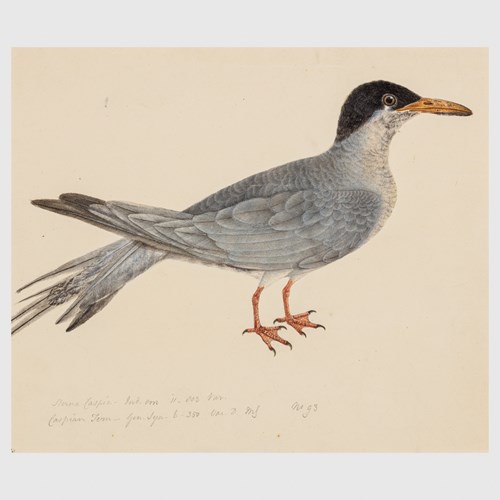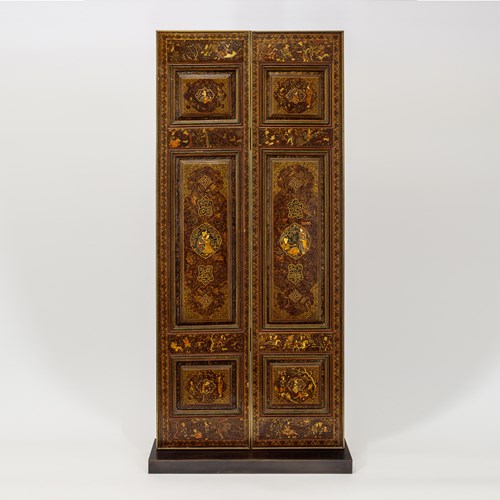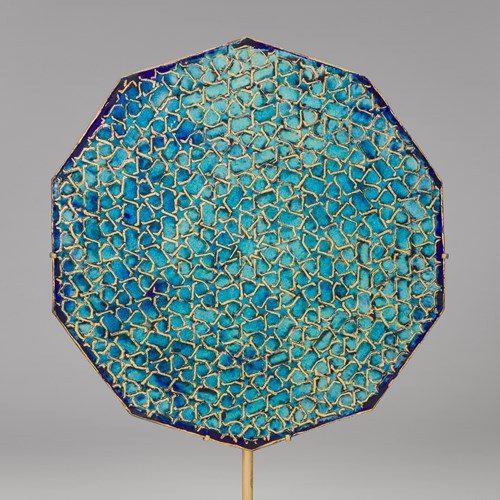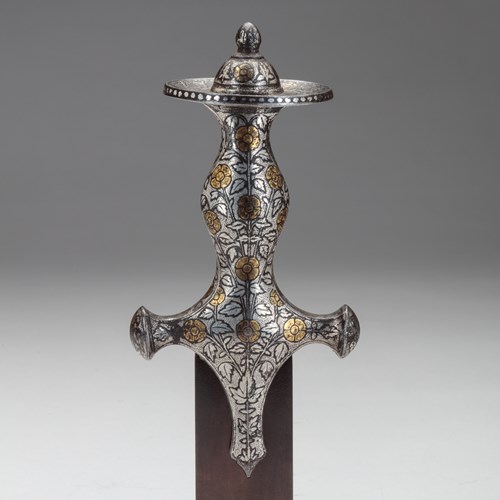Marketplace
A Persian Torchstand or Mash'al
A Persian Torchstand or Mash'al
Epoque Late 16th to early 17th century
Origine Western Iran
Medium Brass
Dimension 22 x 10 x 20 cm (8⁵/₈ x 3⁷/₈ x 7⁷/₈ inches)
This model of torch-stand (Persian: mashʿal), with its tapering central shaft and two strong mouldings, is typical of the Safavid period. The base is unique for its wide flan with inverted edge that is engraved with a vegetal border. The flan is engraved with three-lobed half palmettes, all pointing towards the centre. The shaft is divided into three sections by two strong mouldings, with the central part being chamfered with 12 facets and upper and lower section in cylinder form. The lower moulding has an engraving reads “ʿAli”. The upper section has an everted rim with an S shaped profile on the underside and a flat or slightly dished lip sloping gently inwards on the upper side.
Both upper and lower sections are divided into three horizontal bands by plain metal, with the epigraphic bands in the middle. The epigraphic bands in both upper and lower sections are divided into four sections enclosed by identical cartouches with trilobed frames. In the lower section, the epigraphic band is framed by two bands of lobed palmettes pointing at the epigraphy. In the upper section, the two bands of lobed palmettes that frame the epigraphic band point in opposite direction compared to those in the lower section. The chamfered shaft is encircled by four rows of zig-zag epigraphic bands. In between the zig-zag bands are triangular or lozenge shapes engraved with lotus blossoms and foliage patterns.
This torch-stand’s use of patterns and layout are very typical of Shāh ʿAbbās’s period (r.1588-1629).[i]During that period, Western Iran and Khorasan was the centre for metalwork production. This piece can be compared to a group of torch-stands from the Victoria and Albert Museum (Accession Nos: 481-1876; 44-1870; 483-1876;790-1901), which are attributed to this period. They share similar features, with engraved patterns throughout the shaft, similar choice of poetry on epigraphy bands and the strong emphasize on the architecture of form. The patterns create a strong rhythm that the earlier period has no equivalent. The inverted base can be compared to an example from the Metropolitan Museum of Art (Accession No: 91.1.554a).
Inscriptions:
Upper section:
شبی که ماه رخت شد چراغ خلوت ما
گداخت شمع نیاورد تاب صحبت ما
دمی که از رخ چون مه نقاب بر فکنی
بود بر آمدن آفتاب دولت ما
On that night when Thy Moonface became the light of our solitude
The candle melted unable to bear our companionship
The moment Thou tearest off the mask from Thy moon-like Face
There rises the sun of our good fortune.
(Kātebī Torshīzī, a Khorasanian poet from Torshīz who died in 838 or 839/1434-1436. This verse also appears on three dated torch-stands:
the Metropolitan Museum torch-stand of 986/1578-1579
the Hermitage 987/1579-1580
Musée des Arts Décoratifs 996/1587-1588.)
Lower section:
شبی یاد دارم که چشمم نخفت
شنیدم که پروانه شمع گفت
که من عاشقم گر بسوزم است
تو را گریه و سوز باری چراست؟
I remember one night as my eyes wouldn’t close
I heard the butterfly tell the candle
I am stricken with love, if I burn’tis but right
But you why do you weep, why burn yourself out?
(Saʿadi, Chapter 3, Būstān, 13th century.)
[i] Assadullah Souren Melikian-Chirvani, Islamic Metalwork from the Iranian World, 8th-18th Centuries (London: HMSO, 1982), 309.
Stock no.: A4576
Both upper and lower sections are divided into three horizontal bands by plain metal, with the epigraphic bands in the middle. The epigraphic bands in both upper and lower sections are divided into four sections enclosed by identical cartouches with trilobed frames. In the lower section, the epigraphic band is framed by two bands of lobed palmettes pointing at the epigraphy. In the upper section, the two bands of lobed palmettes that frame the epigraphic band point in opposite direction compared to those in the lower section. The chamfered shaft is encircled by four rows of zig-zag epigraphic bands. In between the zig-zag bands are triangular or lozenge shapes engraved with lotus blossoms and foliage patterns.
This torch-stand’s use of patterns and layout are very typical of Shāh ʿAbbās’s period (r.1588-1629).[i]During that period, Western Iran and Khorasan was the centre for metalwork production. This piece can be compared to a group of torch-stands from the Victoria and Albert Museum (Accession Nos: 481-1876; 44-1870; 483-1876;790-1901), which are attributed to this period. They share similar features, with engraved patterns throughout the shaft, similar choice of poetry on epigraphy bands and the strong emphasize on the architecture of form. The patterns create a strong rhythm that the earlier period has no equivalent. The inverted base can be compared to an example from the Metropolitan Museum of Art (Accession No: 91.1.554a).
Inscriptions:
Upper section:
شبی که ماه رخت شد چراغ خلوت ما
گداخت شمع نیاورد تاب صحبت ما
دمی که از رخ چون مه نقاب بر فکنی
بود بر آمدن آفتاب دولت ما
On that night when Thy Moonface became the light of our solitude
The candle melted unable to bear our companionship
The moment Thou tearest off the mask from Thy moon-like Face
There rises the sun of our good fortune.
(Kātebī Torshīzī, a Khorasanian poet from Torshīz who died in 838 or 839/1434-1436. This verse also appears on three dated torch-stands:
the Metropolitan Museum torch-stand of 986/1578-1579
the Hermitage 987/1579-1580
Musée des Arts Décoratifs 996/1587-1588.)
Lower section:
شبی یاد دارم که چشمم نخفت
شنیدم که پروانه شمع گفت
که من عاشقم گر بسوزم است
تو را گریه و سوز باری چراست؟
I remember one night as my eyes wouldn’t close
I heard the butterfly tell the candle
I am stricken with love, if I burn’tis but right
But you why do you weep, why burn yourself out?
(Saʿadi, Chapter 3, Būstān, 13th century.)
[i] Assadullah Souren Melikian-Chirvani, Islamic Metalwork from the Iranian World, 8th-18th Centuries (London: HMSO, 1982), 309.
Stock no.: A4576
Epoque: Late 16th to early 17th century
Origine: Western Iran
Medium: Brass
Dimension: 22 x 10 x 20 cm (8⁵/₈ x 3⁷/₈ x 7⁷/₈ inches)
Provenance: From the collection of S.E. Claude Achille Clarac (1903-1999), Ambassador of France to Iran (1934-1942). "Purchased with André Godard in Tehran between 1935 and 1937."
Plus d'œuvres d'art de la Galerie


_T638563980781225652.jpg?width=2000&height=2000&mode=max&scale=both&qlt=90)






